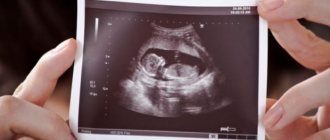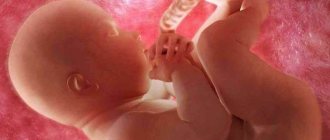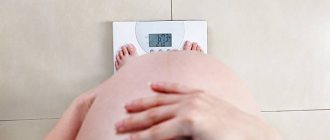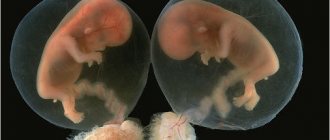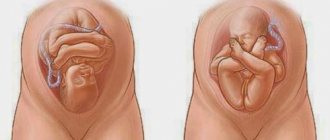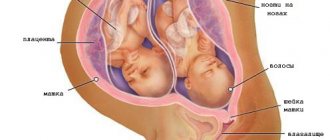Week 13 – end of the 1st trimester of pregnancy. During this period, significant changes occur in the body of the expectant mother and child. Ultrasound examination allows diagnosing problems during pregnancy and deviations in fetal development.
The ultrasound machine is equipped with a sensor, which is a generator of ultrasonic waves, and a monitor on which the image is displayed. Special gels are used to contact the sensor with the patient’s body. The ultrasound procedure at the 13th (15th obstetric) week of pregnancy is absolutely painless and does not cause discomfort.
Mother's condition and how the fetus develops?
At the 13th week of pregnancy, changes occur in a woman’s body: drowsiness and toxicosis disappear, health improves, and an enlargement of the mammary glands is observed. Pain in the lower abdomen may be felt due to an enlarged uterus.
Important! To avoid the threat of pregnancy, if you experience discomfort and brown discharge, you should definitely consult a doctor who is managing your pregnancy!
A natural reaction to changes occurring in the body may be itching in the chest and abdomen. You should not comb it!
By this time, the baby’s organs and systems are formed and actively developing. The size of the head is even larger than the size of the body. The average length of the fruit is 7-8 cm, weight is about 15-30 grams.
The child moves and sucks his finger, his hearing aid can recognize sounds from the outside. The body produces bile and insulin, the baby’s bones become stronger, muscle tissue is formed, and baby teeth begin to grow.
Attention! The expectant mother should forget about bad habits! The taste of amniotic fluid that the child feels depends on the food the woman eats.
Fetus at 14 weeks of gestation: gender, weight and dimensions
At the 14th week of pregnancy, the fetus already shows great activity, and not only motor, but also facial expression: its “attitude to the task” could be read in its face. And the face, by the way, becomes more and more perfect: the ears fall into place, the eyes come closer together, the neck stretches, lifting the chin. The embryonic fluff of the lanugo is gradually replaced by denser hairs, and this week the hair of a future handsome man or beauty may already be born.
The work of the internal organs is becoming more coordinated and improved, the baby is learning a lot now: preparing the chest for breathing (by making movements with the diaphragm), developing the lungs (swallowing and spitting out amniotic fluid, and he can already distinguish between different tastes!), training the lower jaw for sucking and chewing (at 14 weeks the baby is already sucking his finger or fist with might and main).
It is already possible to determine the blood type and Rh factor of a little person (although the composition of the blood has not yet formed) and even the gender of the child (but it is still impossible to determine it on an ultrasound). And you can even listen to the heart with a stethoscope.
Intestinal peristalsis really happens: at week 14, the small intestine begins to move its first contents - bile.
The baby's genital organs are formed and continue to develop: in boys a prostate appears, in girls the ovaries descend from the abdominal cavity into the hip area. True, it is still very difficult to determine on an ultrasound whether it is a baby or a toddler who is growing in the mother’s tummy.
The baby is already long – 8-10 cm, the baby’s weight is 30-40 g.
Future mom
Mom's belly is also getting bigger. If this is not the first time you are pregnant, then perhaps this happened in previous weeks. And now the stomach has risen higher and noticeably rounded. You gain extra weight, but for now this is mainly due to increased blood volume. However, the baby actively moves and develops the muscular system, and therefore requires protein from the mother. You may feel constant hunger, but gluttony is highly undesirable now. Know how to properly plan your diet and diet and under no circumstances overeat at night.
What does the study show?
An ultrasound examination at week 13 allows the doctor to determine how the baby is developing and whether the development of the embryo complies with the norms. And also draw a conclusion about the possibility of spontaneous abortion and the presence of signs of hereditary diseases.
Based on the results of the ultrasound, the doctor can detect the presence of the following anomalies:
- Edwards syndrome. Occurs 1 in 7000 cases. Most often - in children whose mothers are over 35 years old. The study reveals an infrequent fetal heartbeat, one umbilical artery, and the nasal bones are not distinguished.
- Triploidy. The anomaly is accompanied by numerous fetal malformations. Characterized by a triple set of chromosomes.
- Cornelia de Lange syndrome. It is observed in 1 case per 10,000. A hereditary disease in which the patient exhibits growth retardation and mental retardation.
- Smith-Lemli-Opitz syndrome. The disease is associated with metabolic disorders. The result is developmental delay, mental retardation and autism. Occurs in 1 case out of 30,000.
- Down syndrome. One of the most common genetic diseases. It is observed in 1 case in 700 births.
Is it possible to see the gender of the baby?
With a suitable positioning of the baby, it is possible to determine its gender from a photo as early as 13 weeks. His activity can interfere with determining the gender of the child. All that remains is to wait for the next scheduled ultrasound in the second trimester, which will most likely show whether the expectant mother is expecting a boy or a girl.
Will the doctor tell you the gender of the baby at 14 weeks?
Many parents are interested in knowing whether it is possible to determine the gender of their baby at 14 weeks of pregnancy using an ultrasound. Yes, because gender is formed at the genetic level from the moment of conception. But until a certain time it could only be clarified invasively (with a biopsy and blood test). It is at a period of 12-14 weeks that a competent specialist, with good diagnostic equipment, will be able to inform the parents of the gender of the unborn child based on ultrasound results.
But, unfortunately, it is not always possible to determine the sex of the child at the first screening at 14 weeks: during this period the fetus is very mobile, and it can be difficult for the doctor to “catch” a position on the screen where its sexual characteristics can be clearly seen. If your baby “hides” the floor from you by crossing his legs or covering himself with his arms, don’t worry. At the second screening ultrasound, performed from 20 weeks of pregnancy, the gender of the unborn child will be reported!
Determining the sex of the child. There is a boy in the photo.
Interestingly, boys’ sexual characteristics are more often “masked” as girls’. The descent of the testicles into the scrotum normally occurs around 30 weeks of pregnancy. For some, this process is completed after birth. This means that the doctor may make a mistake and name the wrong gender: assume the birth of a girl, especially in the early stages of pregnancy. This is partly why doctors prefer not to inform the gender in advance and not to reassure future parents. Already from 20 weeks of pregnancy, which corresponds to the period of the second screening, establishing the gender of the unborn child will not be a problem.
How to prepare for the examination?
Before an ultrasound scan, a woman needs to have a bowel movement to prevent gas formation. A day or two before your appointment, you should exclude from your diet carbonated drinks, dried fruits, plums, cabbage, flour and other products that cause fermentation and gas formation.
Half an hour before an abdominal ultrasound, you need to drink about 0.5 liters of water; before a vaginal ultrasound, you should empty your bladder.
Reference! The mother's anxiety is reflected in the baby's behavior in the womb. Due to excessive worries, the results of the study may be distorted.
13th week of pregnancy
It is also important that the fetus receives sufficient calcium on a daily basis. To do this, it is recommended to consume some kind of fermented milk product every day - fermented baked milk, kefir, cottage cheese, low-fat yogurt.
During pregnancy, a rather unpleasant problem arises - constipation. They are explained by the fact that the uterus increases in size, rises and begins to put pressure on the intestines. It is not recommended to solve the problem with medication; it is best to adjust your diet, remove heavy and difficult-to-digest foods from your diet, and add more fiber to it in the form of foods such as:
- plum;
- apricot;
- apples;
- beet;
- sea kale.
Also, to normalize intestinal function, you cannot do without a diet. You should not take long gaps between meals. It is optimal to eat 4-5 times a day in small portions. Healthy snacks are welcome.
Alcohol and smoking are prohibited for the entire period of pregnancy, since these bad habits can cause fetal development abnormalities. It is also recommended to refuse or minimize the consumption of chips, crackers, hot spices, marinades, smoked meats, store-bought sauces, strong coffee, and products containing artificial colors and preservatives. It is best to eat main dishes boiled, baked or stewed. It is also better to avoid fried foods on a regular basis.
Screening at 13 weeks of pregnancy: what are the norms?
The first screening raises many questions for the expectant mother. How they do it, what the norms are and what this study should show are some of the main questions.
Screening at week 13 includes: Ultrasound and blood sampling (biochemical analysis). The main task is to determine the presence of chromosomal diseases in the fetus.
Congenital malformations may be indicated by a thickness of the baby's collar zone of more than 3 mm. Suspicions of abnormalities in fetal development (Down syndrome) may arise if the nasal bone is not visible.
According to the results of a blood test from a vein, the main normal indicators at the 13th week of pregnancy are as follows:
- hCG: 14.1 – 114.6;
- RARR-A: 1.02 – 6.03.
Feelings at 14 weeks of pregnancy
Around now, a woman begins to identify herself with motherhood and take on a new role. You think more about the child, pay more attention to things to which you were previously indifferent, change your life views and values.
The situation entirely contributes to this. At 14 weeks of pregnancy, a woman is rarely bothered by debilitating toxicosis. The psycho-emotional state is also put in order.
At the same time, some physiological changes can cause anxiety and somewhat detract from the joy of upcoming motherhood. If in the early stages of pregnancy you may have suffered from excessive oily skin, at this stage, on the contrary, the skin, and along with the skin, hair and nails, become dry. This is a consequence of vitamin A deficiency, which causes peeling and dry skin, brittle hair and nails. In addition, increased needs for vitamin C, if not met, can result in bleeding gums.
And these factors should also become an additional incentive for a woman to carefully analyze what and how she eats. The needs for high-quality food are now much more exaggerated, and the expectant mother’s appetite is now very, very good - toxicosis has receded, and now a pregnant woman can feel hunger anytime, anywhere. It should be remembered that you should not be overzealous with nutrition: despite the common saying that now “you need to eat for two,” in fact it is better to adhere to the principle of “eating for two.” You need to carefully monitor your weight: firstly, excess kilograms gained in the future can complicate pregnancy, and secondly, after giving birth it will be very difficult to deal with them. Therefore, taking into account the recommendations of experts regarding the nutrition of pregnant women, think about revising your diet towards healthy and nutritious foods, limit the consumption of fats, sweets, and flour products. At the same time, do not forget about proteins, fiber and complex carbohydrates.
Do not be alarmed if at some point during the 14th week you suddenly notice pigmentation on the skin, existing or enlarged birthmarks, papillomas (skin growths in the form of soft warts). At this stage, such changes are not uncommon, they usually do not pose any danger, however, it is better to establish the reasons for such changes together with a doctor.
More on the topic
Bloody discharge in early pregnancy
What to do if you have a small belly during pregnancy and it doesn’t grow?
Yellow discharge during pregnancy
Brown discharge in early pregnancy
Discharge during pregnancy
The abdomen gradually grows, becomes rounded, and a dark stripe may already appear on it, running from the navel to the bottom. The skin on the abdomen will stretch as it grows, therefore, in order to avoid the appearance of stretch marks, it is worth taking care of special cosmetics. Very soon, mom simply won’t fit into her “pre-pregnancy” things.
And now, for maximum comfort, you should change your wardrobe by buying yourself a few items made in a special loose cut for pregnant women. You may have done this at another 12-13 weeks. But if not, there is no point in delaying. Any tricks and devices in your previous clothes will not last you very long.
If you spend a lot of time on your feet, consult your doctor about a bandage - perhaps it will make it easier for you to bear a small but already noticeable belly.
What can be seen in the photo of the fetus?
In the picture you can already see the outlines of all parts of the body (not very clear), including the baby’s facial features.
In the photo at 12, 13 weeks, the fetus already looks like a baby, only very small. The head already corresponds to the size in relation to the body. Tiny fingers can be seen on the arms and legs.
If the position of the fetus is successful during the examination, it will be possible to see the genitals and find out the sex of the child. The baby may grimace, and if you're lucky, the photo will capture the moment he yawns or smiles.
Photo of a boy
Photo of a girl
Decoding the norm
During the study, the following indicators are assessed:
- fetal heart rate (FHR);
- coccygeal-parietal fetal size (CTF);
- collar space thickness (TNT);
- biparietal fetal size (BFS);
- abdominal circumference;
- length of the nasal bone;
- thigh length.
Table: normal indicators for week 13
| Index | Norm |
| Heart rate | 147-171 beats/min |
| KTR | 62-73 mm |
| TVP | 1.7-2.7 mm |
| BPR | 20-28 mm |
| Abdominal circumference | 58-80 mm |
| Nasal bone length | 3-4.2 mm |
| Thigh length | 7-11.8 mm |
Interpretation of ultrasound indicators of the first trimester
TVP: norms and deviations
The TVP, or cervical fold, is where fluid collects under the skin layer at the back of the embryo's neck. The assessment of TVP is very significant in terms of intrauterine development. After about 14 weeks, the fluid under the skin begins to gradually be absorbed by the lymphatic system of the unborn child, and therefore the assessment of this parameter loses its relevance.
Depending on how the ultrasound examination is performed (transabdominal or transvaginal), the corresponding values of this criterion will be identified. That is, they will not be equal. However, in the first case they should not exceed 3 mm, in the second they should be more than 2.5 mm.
Starting from the 11th week of pregnancy, the TVP takes on dimensions of 1-2 mm, which can be traced at a period of 12 weeks. But for the intrauterine period of 13 weeks, a TVP value of 1.7 mm is considered more typical. At the same time, the standard minimum and maximum values for TVP at 13 weeks range from 0.8 to 2.7 mm.
However, identified deviations from normal TVP values at week 13 are not yet considered as a final diagnosis.
Measurements of the collar space are needed to determine whether a pregnant woman belongs to a risk group. It may be necessary to undergo additional tests to make sure that the child has a certain chromosomal disorder (Down syndrome, Edwards syndrome, etc.).
The statistics are that only 7% of children who had abnormalities in the TVP parameter at 13 weeks are born with Down syndrome. If there is a reason for further examination, you should not worry under any circumstances, since this is not yet a death sentence.
But if the TTP norm is exceeded, the pregnant woman will definitely be sent for additional examination. You should be vigilant when a blood test for hormones also shows poor results and a chorionic villus biopsy confirms the presence of chromosomal abnormalities.
Even if you undergo all the studies in the 1st trimester to study the nuchal translucency and if abnormalities are detected, you should not panic. After all, the only accurate diagnostic technique is amniocentesis, performed after the 16th week of gestation. Very rarely the TVP value shows more than 4-5 mm. However, even with such data, at week 13 there is every chance of carrying and giving birth to a completely healthy baby (in 50% of cases). The main thing is to keep faith and not get upset, since stress is dangerous not only for the mother, but also for the fetus growing in the womb.
